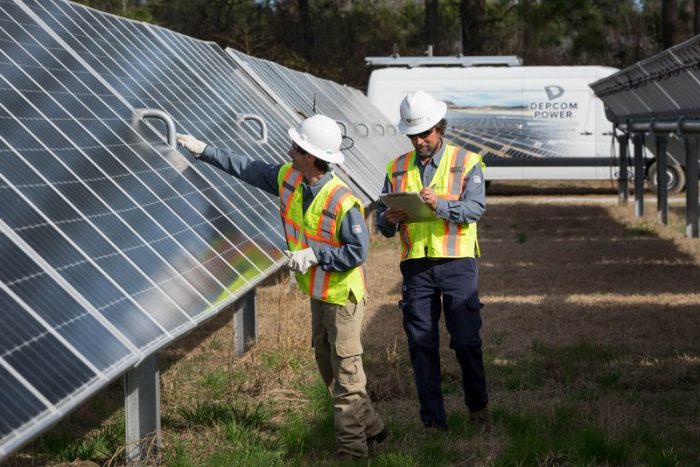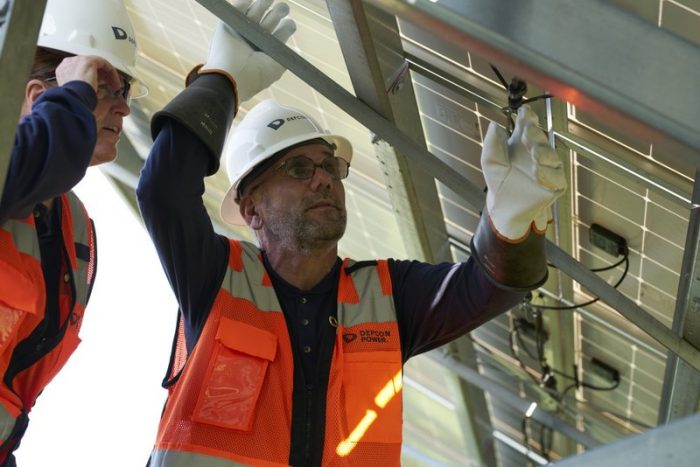
Photo Credit: DEPCOM Power: A 70 megawatt solar facility DEPCOM Power is currently constructing for its customer in North Carolina. By Ian Steele, SVP of Services, DEPCOM Power
As published in the October issue of Solar Builder Magazine.
As the dog days of summer come to an end, heat waves are fading as fast as the leaves are changing colors. Owners and operators of solar plants can look forward to spending the next few months catching up on items pushed to the side during the busy summer months. Ensuring plants are prepped properly for winter can save you and your O&M teams valuable resources in the long run.
The perception among utility plant operators and owners is that during the winter months, their plants will have lower production due to the shorter irradiance days. While this is true, several critical O&M strategies can be implemented to keep up shoulder-month performance and mitigate losses.
Here are three actionable strategies to help your plant perform at its best throughout the shoulder months and well into winter.
Technicians and training

After long, hot days and weekends working to keep plants performing at peak, operators look forward to a slower pace during the winter months. But your site can deteriorate quickly during the shoulder months without top-performing technicians to keep running smoothly. That’s why you should strive to train your technicians to take advantage of the shoulder season to keep your plant running optimally.
Here are a few things you and your team should keep in mind as autumn comes into play.
- During summer months, it’s not unusual for training and recertifications to lapse as crews spend their time keeping plants operating at peak performance. Now is the time to double-check everyone’s safety and training certifications and implement training to bring everything back into compliance.
- School is back in session. Be aware of road changes and increased activities on the roads around your facilities. Limited daylight demands that technicians go on high alert to keep the surrounding community safe. Slow down while driving and be hyper-aware of your surroundings. Watch out for children particularly around bus stops and be mindful of lower visibility at dusk and dawn.
- Assess and document any issues that cropped up during the summer while memories are fresh. Now is the time to take stock of lessons learned and challenges in preparation for next year. Create a checklist of issues you and the team can improve upon next summer.
Panel washing
Manufacturers and owners believe summer’s long days are the best time to wash panels for peak production. But it’s not the only time you should scrub away the dirt. Module washing before winter sets in can improve your plant’s power curve through the year’s end.
- While summer’s longer days mean extra production hours, shoulder-season washing steps up performance when it’s most needed, giving you the best performance during the limited number of hours in winter months.
- Plants in rural and agricultural areas tend to get dirtiest in the summer because of farming activities and dusty, dry roads. Autumn washes prevent dirt from clouding panels as fall and winter rains begin to fall, which otherwise could reduce solar production.
- Dry, hot summer days can cause thermal shock during panel washing. With the onset of cooler weather, however, thermal shock is minimized, and runoff wash water causes less streaking or hard-water deposits on panel surfaces.
Firmware and controls housekeeping

Homeowners are encouraged to inspect the batteries in their smoke and carbon monoxide detectors as the days shorten. Similarly, the approach of daylight savings time is a good time to inspect PV plants for summer’s wear and tear. Operators should look into firmware and controls for any needed updates or other issues. Among the things to watch out for during shoulder season:
- Check trackers’ incident angle and adjust for sun movement in the fall. The sun begins its move south after the autumnal equinox, reaching its most southerly point at the winter solstice on Dec. 21. Ensuring trackers have taken this into account provides optimal daily performance. Confirm that the tracking control system’s critical firmware is up to date.
- Account for shading from shorter days to improve performance. Shading profiles from trees, landscaping, and even your built environment can shift rapidly from day to day; make sure your tracking software takes this into account as daylight hours decline.
- Inverter ramp-up times and firmware. With later sunrises and shorter days, it is crucial to confirm your inverters and other plant infrastructure are operating with the latest software. Plant performance can degrade with even such simple things as failing to adjust for a time change or bad timing on sunrises.
Tip 10: Take this time to slow down and reflect on your summer successes even as you make the fall-to-winter transition. These simple but important strategies will keep your O&M teams operating smoothly and ensure optimal plant performance and revenue.
Ian Steele is SVP of Services – DEPCOM Power. Ian brings over 15 years of construction and O&M experience across solar, wind, hydro, and conventional power sectors. Having led some of the largest O&M service teams in the nation, Ian is now expanding DEPCOM Power’s Repowering, Recertification, and Restoration services for operators nationwide. Since 2014, DEPCOM Power has delivered O&M services for nearly 2 GW of solar plant projects with a mobile, highly trained in-field team providing 24/7 operational response, and an average 99.4% fleet availability.